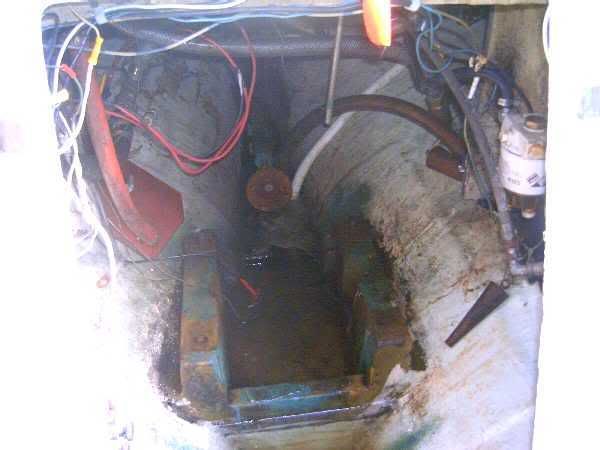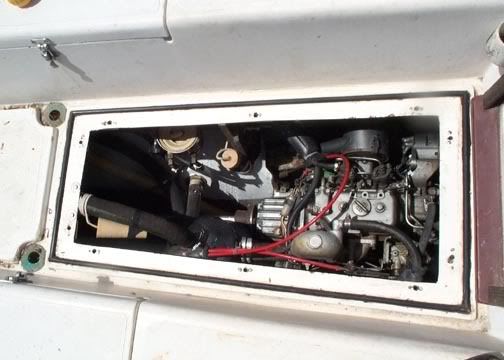I?ve finished gutting out and scrubbing down the once-and-future engine compartment of my boat and have started to give some more thought as to the general layout of where various equipment should be installed. However, a satisfactory arrangement with a new fuel tank installed (18 to 20 gallons) that would allow for improved stuffing box access continues to elude me, so I thought I?d try sounding the board for input.
Here?s a shot looking aft into the newly cleaned, but not yet painted, engine compartment and cockpit lockers to give you some idea of the space:

At the top of the photo you can see the metal scuppers protruding from the front corners of the cockpit, and behind each scupper you can see 2 fiberglass legs onto which the original fuel tank (25 gallons) mounted. In order to try to give you some three dimensional sense of the space, the fiberglass slab from which you see the stuffing box protruding is directly below the front edge of the cockpit sole. This diagram from the Tripp 30 brochure might also help:

My fundamental problem with the standard factory arrangement is that there does not seem much in the way of practical access to the stuffing box. With the engine installed, access from the front is considerably impeded and you would have to go-go gadget arms in order to try to reach over and behind it. If the new fuel tank occupies the same location as the old one, then that would rule out installing an access hatch in the cockpit sole because it would just open onto the top of the tank. Mounting the new tank in a locker area would result in the loss of that space and would also have a detrimental effect on the boat?s trim. And trying to mount a long narrow tank farther back along the centerline, so that it would only protrude partly into the lockers, would run afoul of the rudder post raking back.
Another option would be to install a considerably smaller fuel tank, but that option is not particularly appealing to me. So, at the moment, I?m reluctantly leaning toward the standard factory arrangement and hoping that access won?t be as bad as I envision, but I?d still like to hear what others think.
Other items under consideration that I wouldn?t mind hearing some opinions about:
(1) Ditching the fin. Underneath the after end of the cockpit, you can see the backing plate and 8 bolts that hold the fin modification in place. If I were ever going to get rid of the fin, this would seem to be the time to do it, while everything is emptied out and access is optimum. I also have to strip the bottom paint in the spring anyway so bottom work is on the horizon. On the other hand, I?m still not sure why it was installed and thus I don?t know if there is actually a very good reason for the appendage.
(2) Seacock replacement. I had planned to simply service those factory original bronze seacocks you seen in the top photo. However, closer inspection of them reveals that there are no bolts in the seacock flanges leading me to believe they?re just screwed onto the through-hull fitting. The through-hull itself appears to have its flange glassed over into the hull so that only the pipe protrudes. On the one hand this arrangement has apparently been solid enough to see the boat through the 43 years since its building, but on the other hand I?d feel more secure with a seacock that?s firmly bolted to the hull.
(3) Starter battery placement. I?ve been considering mounting the engine starting battery on the flat fiberglass platform located on the starboard side of the boat (you can see its square shape protruding on the left side of the photo). I suspect a blower for the A4 might have originally been mounted there. However, in order to prevent heat damage to the battery, I was wondering if this would be too close to the new diesel and pondering just how far away the battery should be from the engine in order to negate this concern.
(4) Engine compartment/locker bulkheads. Should I build wooden bulkheads on either side of the engine compartment to further divide the area from the lockers and provide surfaces onto which soundproofing insulation could be attached?
(5) My bilge situation, proper drainage, and electric pump placement but that?s probably a topic for another thread!
AJ




